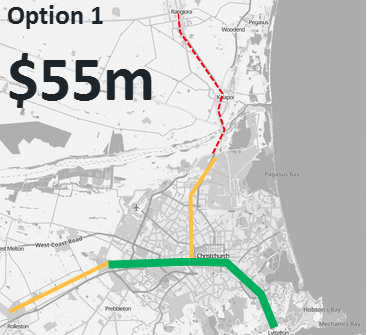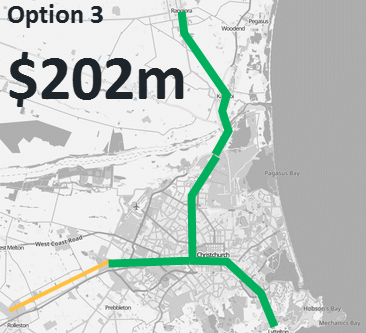A couple of weeks ago I wrote about a report Ecan commissioned in 2014, which concluded that a bare bones commuter service was technically feasible, relatively cheap at $8m, and would most likely attract the 500 daily passengers it needs to be financially viable. Now I’m going to describe an earlier report from 2005 which investigated more comprehensive rail services.
The report itself seems to no longer be on the ECan website, but most of the content can be pieced together from wikipedia, Lincoln University, stuff, and various blog-type discussions.
It was mainly a costing exercise – trying to answer the question “how much would it cost us to get trains going again in Christchurch”. It doesn’t attempt to go into any sort of discussions about the benefits of trains, likely patronage, the reasons for running them, the strategic transport direction we should be taking, or whether they are a good idea or not.
It looked at 5 options. Option 1 was sort of a bare minimum required to get something off the ground, although still included more features than the bare bare minimum described in the 2014 report. Option 5 was an “all-the-bells-and-whistles” arrangement with all sorts of features (including a tunnel underneath the CBD). Options 2, 3 and 4 were various states in between these 2 extremes.
Each of the 5 options are summarised below in terms of what frequency service they would allow. The trouble with the existing lines is that in many places they are only single track, and have only very basic signalling systems. Whilst these can still be used for passenger trains, they could only accommodate very low frequency services. If we want higher frequency we need to double-track them and upgrade the signalling, and in some cases do other work too (like upgrading junctions and stations).
Green = high frequency (defined as 30 minute headways), yellow = moderate frequency, red = extremely limited frequency.





Last post I used some graphs to try help put the costs into context. Here are the same graphs tweaked to include the 5 train options:

One thing to be careful of is that the rail prices are in 2005 dollars, whilst the other values on the chart are 2018 dollars. So really those rail costs will be higher – maybe something like 20-30% more. Also the report contains plenty of disclaimers that the costs are only high-level estimates and could be out by -50%/+100%.
Taking this inherent error into account, it still shows that the first couple of options are likely to be relatively cheap compared to other transport projects we’re doing around the city. Options 3 and 4 would probaly be of comparable price to the 3 motorway/expressway projects we’re currently doing. Option 5 would cost quite a bit more (most of this is for the underground tunnel).
Something I haven’t put on this graph is the public transport equivalent that the draft public transport plan proposes – twin rapid transit corridors heading north along Papanui Road, and southwest along Riccarton and Main South Roads. If these were light rail, they would be significantly more than all 5 rail options, even the one with the underground tunnel. The currently under construction 12km Canberra light rail is costing roughly $700m. If we had two of these it might in the order of $1,400m, way off the top of that chart. If they were bus rapid transit they would be cheaper, possibly something comparable to the rail options costed above.
What do you think about all this?
Chris the Reserve Bank have a tool to convert prices from different years.
https://www.rbnz.govt.nz/monetary-policy/inflation-calculator
LikeLike
Yea I thought about doing that but ran out of time, and also when I saw the error was -50%/+100% anyway I figured not adjusting for inflation is not the biggest issue.
LikeLike
For me, this illustrates how you can incrementally phase in rapid transit using the rail infrastructure. For instance, if you start with something akin to the 2014 report then add to that over time to expand its reach, capacity, frequency, and overall quality towards something like option 5; this phases the costs, breaking them down into affordable, yet effective, stages.
Arguably, this is what Auckland did with their metro system, and this is exactly what is proposed (first stage just approved for funding by NZTA) for the Hamilton-Auckland corridor. Why is this approach not being championed by local government in greater Christchurch?
LikeLike
Yea we could start with option 1, then over a few years roll out each section until eventually we have option 4. The only thing you need to be careful of is making sure the first stage has enough that it is actually successful. There’d be nothing worse than doing option 1 and finding no one uses it because it’s too limited.
LikeLike
Agreed. A minimal level, or standard, of service to be effective would need to be part of any business case or study. The 2014 study indicated it was broadly worthwhile, but more detail would be needed to ensure what level of service will result in (enough) mode shift.
LikeLike
And the other thing affecting staging is trying to build it in conjunction with developments. For example the UDA might be able to combine upgrading the line out to Rangiora with a big housing development that way, clustered around a station.
LikeLiked by 1 person
Interesting reading thanks, Chris. How sad none of these options were done. I’d push for option 3. Seeing the number of sites still undeveloped within the more central area of Christchurch, the opportunity for creating a compact, liveable city is great – only limited by business as usual thinking. You’re right that getting the developments right at the same time is key, which is why I’d go for option 3. Some money needs to be reserved to spend on leading the way with high and medium density development in the centre.
If compulsory acquisition is used, it should be near the most central train stations. Car yards and big box retail at grade car parks next to train stations are like dunce caps for the city planners. 🙂
LikeLike
Interesting discussion on Transport blog a few years back on train options for Christchurch.
https://www.greaterauckland.org.nz/2014/04/24/christchurch-to-use-aucklands-old-trains/
LikeLike
A project in Melbourne extended an existing rail line into a new suburb… it included a 6km extension, new station and a grade separated crossing. It cost $450m. I’ve always felt that the price tags for a Christchurch railway have been very low, not accounting for car parks, platforms, duplication, etc. If we do it, we should go ‘large’ and plan to attract people onto it, but the cost will be initially difficult to swallow. But there should be no reason why the Christchurch sub region couldn’t do it, given our growth projections. Especially if we strategically target growth / development as part of an integrated urban strategy. I recall in the UK there was a ‘regional development agency’ mechanism which had certain planning and compulsory purchase powers and master planning to redevelop huge areas, in coordinating with transport packages (e.g. temple quay, Bristol). What similar approach could we take here to render the railway as financially viable? I’m sure our current planning legislation could be used to this end..
LikeLike
Sounds kind of similar to the recently see up housing and urban development agency https://www.beehive.govt.nz/release/new-urban-development-agency-unveiled-build-more-homes
Would be good for
Greater Christchurch to make use of this, as Auckland and Wellington are starting to.
LikeLike
I think the real problem we are dealing with is that the Auckland and Wellington rail PT networks were established a long time ago under different political climates. Wellington is the best example I have some knowledge of. The government started working on their rail commuter network in the 1920s by building the Hutt Valley railway and then in the 1930s, electrifying it and adding commuter trains. I presume something similar was done in Auckland but they had to wait much longer for double tracking and electrification.
Because whilst we did have a sort of commuter network in Christchurch, it was never developed to the same level as in Auckland and Wellington. Only the railway to Lyttelton had anything close to high frequency and the tram network in the city was openly in competition with the rail commuter trains. Stations were further apart than in other centres. The trains got less and less in frequency as time went on and were eventually killed off by the National government.
It seems the current government is super beholden to the bureaucrats and will not commit one cent of their promise until NZTA has proved there is a business case for it. I don’t recall this amount of red tape when Labour set up ARTA and started on the DART project in Auckland in the mid 2000s.
LikeLike